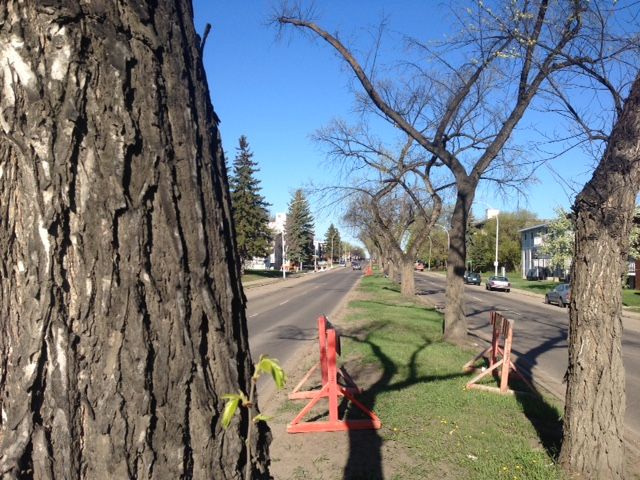City council will be asked next year to invest millions into updating Edmonton’s tree protection plan, knowing that a large upfront cost will pay off over the coming decades. The proposal is based on a report reviewed by council’s urban planning committee on Wednesday.

City forestry staff have been running some numbers through what they call a “tree calculator” that says, based on thousands of trees today, the payoff will be in the hundreds of millions of dollars over the next 50 years.
Scroll down to read the Edmonton tree plan report.
Program options will be brought to city council in late spring next year, said Gord Cebryk, the branch manager for parks and roads.
The options will include educating developers and those in the construction industry of best practices so when trees are planted, they’re not dying off. The goal is to grow the city’s canopy from the current 10 per cent to 20 per cent coverage.
“We see right now about 3,000 trees dying per year and that’s from varying reasons,” said Crispin Wood, the city’s manager of urban forestry.
“In some cases, that’s just the stress of the drought. In some cases, that’s the tree reaching the end of the life cycle, because trees only have a specific life span.
“So we plant the orange dot of death on the trees and we remove them and we have an active replanting program. Those trees will be replanted within one to two years of being removed.”
The calculator, which is a new measuring tool the city is using, would see a massive investment in the early stages, but more than offset in later years.
No specific numbers are available, however Wood said the longer the life of a tree, the better the payoff. It uses 50 years as a base, but he mentioned they know of trees in Beverly that are between 70 and 80 years old.
READ MORE: City committee votes in favour of bylaw aimed at preserving Edmonton’s old trees
“This is all new, in terms of truly understanding what the value of trees are,” Cebryk said.
“If you look at trees from an asset perspective, most assets decrease in value, whereas trees are quite different in that they actually increase in value to a certain point.”
Cebryk added that research shows the asset value of an urban forest provides other returns.
“I don’t know if trees are really viewed as an asset before or more as just a nice aesthetic feature but they do bring so many benefits to a location when you look at that tree calculator. That’s what it tries to do — is capture and identify what those benefits are.”
Those benefits include storm water retention, increased property value, energy savings, improved air quality, and carbon dioxide reduction.
“That’s got to be taken into consideration,” Wood said. “It’s not just the cost of replacing the tree every five years; it’s the opportunity cost of not having a mature tree on the site.”
The report recommends new improved methods in planting trees where the hole is dug deeper, and improved techniques will allow the soil to stay loose, instead of getting compacted, so the root system can continue to thrive.
One way to imagine the loose soil method is to envision those four-pronged protectors you find in a pizza box, only on a large scale They would be stacked so the layers of soil won’t harden, allowing the roots to expand.
City of Edmonton – Tree Protection Plan by Anonymous TdomnV9OD4 on Scribd
Urban Street Trees - Draft Reinvestment Strategy by Anonymous TdomnV9OD4 on Scribd






Comments